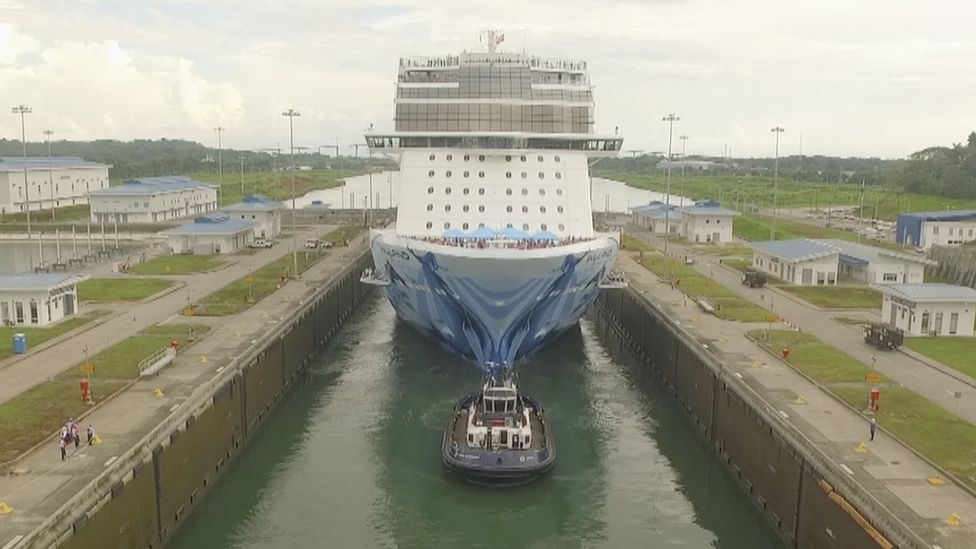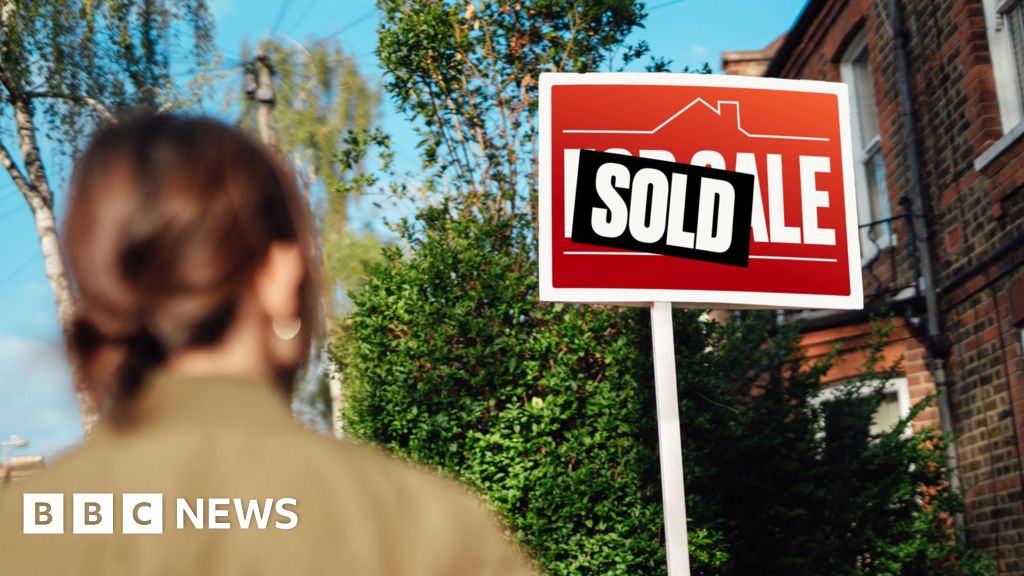ARTICLE AD BOX
 Image source, Panama Canal Authority
Image source, Panama Canal Authority
Water levels of the Panama Canal are the second lowest they have been in 110 years
By Michelle Fleury
North America Business correspondent, Panama
The most famous waterway in the Americas is running dry.
Unlike the Suez Canal, the Panama Canal is fed by a freshwater lake, Lake Gatún, and its water level is falling critically low.
After a choppy boat ride across Lake Gatún, Nelson Guerra, the Panama Canal Authority's hydrologist, points toward a rusted ruler beneath a tower on the western end of the water.
"The level, as you see on the rulers, is 81.20ft," he says. "The level should be five feet more than now."
On the return journey, the boat passes old tree stumps sticking out of the water. They were never fully cut down during the original construction of the lake. Normally, only a few would be visible at this time of year. But half way through the dry season, there's a forest of them.
Nelson Guerra keeps a close eye on water levels in Lake Gatún
The Panama Canal is reliant on rainwater, which is in short supply.
A lack of rain and the El Nino weather phenomenon have contributed to the second driest year in the canal's 110-year history.
Last October was the driest month since records began. The canal region saw 41% less rainfall than normal, and the drought threatens to continue disrupting the $270bn (£213bn) worth of cargo that flows through the Atlantic-Pacific shortcut annually.
They've had to introduce water-saving measures, which has meant fewer ships can pass through the canal each day. This is because water from the lake is required to operate the canal's locks.
The number of vessels has been slashed from an average of 36 to 24. Each ship is also carrying less cargo now because of weight restrictions.
The slowdown spells trouble for global trade.
In normal times about 5% of global maritime trade uses the Atlantic-Pacific shortcut, and 40% of US container traffic. If the route runs dry, shippers will be forced to find alternatives - lengthening journey times and pushing up costs.
And the lack of water is not just a problem for global trade. The Panama Canal Authority also supplies drinking water for half of the country's population, including the residents of the capital, Panama City.
But those who run the canal are taking steps to ensure it remains viable for another century, and beyond.
The Panama Canal Authority's first ever chief sustainability officer, Ilya Espino de Marotta, says they are working on finding solutions to ensure the canal does not run out of water.
Ilya Espino de Marotta is leading efforts to ensure the canal has enough water to operate
"We don't want this to be a recurrent issue. We don't want to drop transits or tonnage," she says.
The authority has been busy developing a plan to invest $8.5bn in sustainability projects over the next five years that it hopes can help the vaunted waterway survive, even as changes rock the planet.
Addressing the changing climate, Ilya Espino de Marotta says: "Panama is a very rainy country… but we see there's a [reduced rainfall] pattern coming that is impacting everywhere. So we definitely need to prepare for the future."
One obvious measure involves water conservation.
The Panama Canal works by transiting boats through a series of above-sea-level locks fed by Lake Gatún and the smaller Lake Alajuela.
Each ship that passes through the locks uses around 50 million gallons of water, and a handful of new locks built in 2016 - the larger Neo-Panamax locks - save 60% of that water.
However, the older Panamax locks remain in operation, and overhauling them would be a major project. In the meantime, the canal authority has found ways to reuse water from one lock chamber to another, so called cross-filling, saving the equivalent of six daily crossings.
The authority is also considering building reservoirs, its first major project since it completed the new set of locks in 2016.
To save more water in rainy months and increase supply in drier times, it wants to dam up the nearby Indio River, and pipe the fresh water into Lake Gatún, the canal's main reservoir. The plan would increase vessel traffic by 12 to 15 a day.
Moving forward won't be easy though. The project doesn't have congressional approval yet, and construction will take several years to complete.
Another option is to build desalination plants. The lack of rain has increased the salinity of the lakes and rivers, a challenge that has to be managed given it's the country's biggest source of potable water. But that option is costly and removing salt from seawater requires a huge amount of energy.
Even seeding clouds in the hopes of creating more rain isn't off the table. The process of implanting large salt particles into clouds to boost rainfall sounds futuristic, but has been around since the 1940s.
A solution needs to be found lest global trade, which has become more unstable this year, gets even more so. Trade volumes through the Panama Canal have fallen 49% compared to its peak.
José Cervantes, a general manager at the Panama branch of shipping company Agunsa, says their daily operations have been hit. Shipments of two million tons of goods from textiles to food have been delayed because of the disruptions at the Panama Canal.
He says the problem is that there are no other good shortcuts.
José Cervantes' company had to switch cargo to road and rail alternatives
Some ships carrying cargo from Asia were rerouted through the Suez Canal, before the current Red Sea crisis. With that option less secure, there's been an increase in demand for rail and road transport across Panama.
But José Cervantes says all that unloading and reloading of cargo from ships onto trains and trucks is pushing up costs. "And those costs are usually passed onto the consumer," he says.
If rains arrive in May as expected, the canal plans to increase the number of ships that can pass through its locks, but that is only a short term solution.
Changing rainfall patterns, serve as a reminder of the major impact climate change could have on global trade and on the long term future of the Panama Canal.
For more on this topic, listen to Business Daily: Disruption and drought in the Panama Canal on BBC Sounds.

 10 months ago
43
10 months ago
43








 English (US) ·
English (US) ·